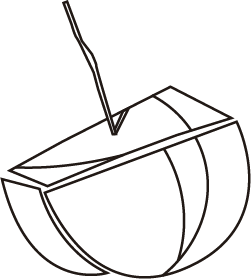The Llacuna pond (known as La Bassa de la Llacuna, in Valencian) is located within the limits of La Vall de Gallinera but borders with the Vilallonga municipality. It is a pond formed by the accumulation of clays, in a depressed area that collects rainwater and keeps it there throughout the year, although the level may fluctuate somewhat. Next to the pond there is an underground cistern with the typical structure used in this area: externally it is a cylindrical shape topped off with a rounded dome, entirely built of stone and lime mortar, and sometimes just by using the dry stone technique. The inner part of the cisterns was excavated into the ground or, more frequently, people took advantage of a chasm which was probably covered with a layer of lime mortar, or with cement in more recent refurbishing projects, in order to prevent water leakage. Water is collected through openings, sometimes with a tile positioned so as to direct the entry of the water; the surface from where the water is collected varies and can be from the roof of the farmhouse or livestock pen or directly from the ground near the cistern. There are many cisterns in the La Llacuna plain and on the slopes of L’Almirant, probably as many as there are pens. Therefore, the livestock pens and the cisterns are definitely the most relevant anthropogenic structures in the area.
To go to La Llacuna from the village of Benirrama it is necessary to go along the cobbled path, the old Ebo path, and, after crossing the county road, walk down towards the Gallinera River. From there, a part of the Rock Art trail should be followed to the left, in the direction of Benialí. Soon enough, there is a crossroads with an indication for the path that goes up towards La Llacuna. The trail goes to Les Rotes and to the forest track that connects with the new road that links Vilallonga with the La Vall de Gallinera and L’Orxa. This path is in good conditions, with dry stone walls and, in some sections, with steps and cobblestones. It is known as the slope of Els Cocons or Costera d’Enmig (the middle slope). The trail passes the Amparets ravine on the right, as well as Uncle Leandro’s pen, which is greatly dilapidated and totally abandoned. Almost at the top of the path lie the livestock pens known as Corral de Molines and Corral del Peó, one next to the other, with their cistern and stone troughs. Where the trail meets the dirt track, the Botana pen can be visited with its majestic fig tree. The dirt track leads to the pond and its surroundings, full of old livestock pens, many of which have been transformed into country houses.
The plain of La Llacuna is a hanging valley, with a flat bottom, completely surrounded by mountains, which give it shelter and contribute the sediments which nourish it. It is a polje, a karst field, where marl clays have accumulated, a red and deep soil, very suitable for cultivation. The result has been the formation of a much appreciated landscape. To the north it is limited by La Safor and to the south by L’Almirant. The water drains away through various chasms such as the Vidre, Esmoladora or Gorga chasms (Gil, 1990). It is often thought that L’Admiral is separated from La Safor, but they embrace to the west and to the east and in the middle is that closed, hanging valley known as the plain of La Llacuna.






